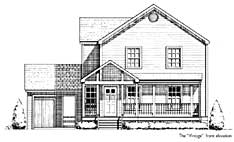|
|
"Documenting what happens over the course of a development project - what worked and what didn't - is an extremely powerful capacity building tool for any community development organization. Creating and maintaining a design focused "project book" as part of this process will improve the design quality of any current development and help build the capacity to deliver well designed developments in the future."
Maria Gutierrez,
Local Initiatives Support Corporation,
New York, New York
Tools for Step 1
Print Step 1
|
|
|
Step 1. Start a Design-focused Workbook for the Project
Why is this step important?
Over the course of the development process a series of key decisions are made which strongly impact the overall design quality of a finished project. The Design Advisor has identified twenty of the most important decision points and organized them into a series of 20 Steps to Design Quality.
A design-focused Project Book, created at the very beginning of the development process, will help ensure that these Steps to Design Quality are actually taken and that the results are collected and used.
Such a Project Book will:
- help guide the design decision-making process;
- provide a structure for formally recognizing each key decision as it occurs and for recording the results;
- create a record of the design process - what worked and what didn't - to help guide future development activities.
When should this step be done?
As early as possible in the Concept phase of development.
Who should do this step?
What should be done?
- Obtain a loose leaf notebook with at least 20 section tabs.
- Print out the Cover, Introduction, and Master Checklist sheets and insert them in the notebook.
- Print out the rest of the Project Book in one of three ways:
- Print the entire Project Book (a PDF file of over 100 pages)
- Print each step and its accompanying forms or checklists as you encounter it on the web site.
- Insert printed steps (all, some or one at a time) along with their accompanying forms and checklists in the notebook at the appropriate tabs.
- As you complete each step, fill out the forms and checklists required and record the completion date on the Master Checklist at the front of the Project Book.
- The Project Book is intended primarily as a field manual to help structure and record decisions as they are made. It is designed to be used interactively with the Design Advisor which contains a wealth of detailed resources, illustrations and case studies that will help explain and reinforce the information provided in the steps.
How can doing this help move my project forward?
- Maintaining a detailed, well organized workbook focused on design issues will help clarify design decision-making throughout the project.
- It will also add credibility to your development - among neighbors, funding agencies and regulatory bodies - as one that is seriously and systematically pursuing design excellence.
- Finally, the completed Project Book will provide a comprehensive record of design decision-making that will help guide your next project and, in the process, enhance your reputation as a development organization committed to design quality.
|
